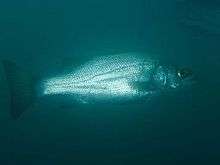Blackfin seabass
| Blackfin seabass | |
|---|---|
 | |
| Not evaluated (IUCN 3.1) | |
| Scientific classification | |
| Kingdom: | Animalia |
| Phylum: | Chordata |
| Class: | Actinopterygii |
| Order: | Perciformes |
| Family: | Lateolabracidae |
| Genus: | Lateolabrax |
| Species: | L. latus |
| Binomial name | |
| Lateolabrax latus Katayama, 1957 | |
The blackfin seabass, Lateolabrax latus, is a species of Asian seabass native to the western Pacific in the coastal waters of central Japan and South Korea.[1] This species is found in shallow waters in rocky areas, in demersal marine environments where the number of large predators such as sharks is low, and the population of prey species such as crustaceans, worms, shellfish, and small fish is high. It can reach a length of 94 cm (37 in) and has been recorded weighing up to 9.1 kg (20 lb). It is a commercially important fish,[1] but is commonly referred to accidentally as the black sea bass (Centropristis). It is also a very popular game fish, and is commonly farmed for a variety of reasons, from being kept in aquariums, game fishing, fertilizer, and food for marine zoo creatures. It is known as the blackfin due to the color of its fins, although the fry and juvenile specimens do not gain this fin color. Despite its size and role as a predatory fish, it is considered harmless to humans, as no attacks from blackfin seabass have ever been reported.[1][2]
Use in cuisine
The blackfin seabass consumption is widespread in sushi bars and restaurants in different areas of Japan.